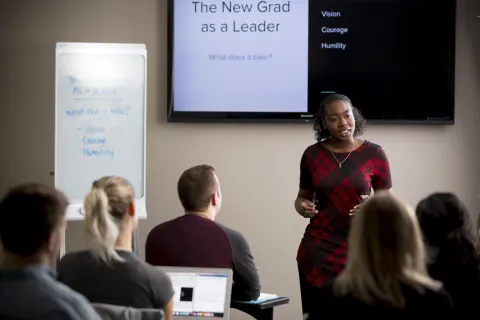Creating a Lesson, Lecture or Presentation
Creating a Lecture or Presentation
When creating a lecture or presentation, there are a few rules to keep in mind. These rules are suggestions that can help you as a presenter, and also help your audience follow along better:
The 10-20-30 rule
Guy Kawasaki created this rule when he worked at Apple. 10 refers to the number of slides you have in your presentation. Obviously this only applies if you are using slides to enhance your presentation or lecture. 20 refers to the time limit of the presentation. This means you should spend about 2 minutes per slide. A change every 2 minutes is great because it helps the audience refocus. It keeps the lecture from getting boring and repetitive because the change comes with a visual cue. 30 refers to the font size on the slides. A 30 point font is great for visibility. It also limits you from putting too much text on your slides.
The Chunking Rule
Students will have an easier time remembering something if you split it into 3, 5, or 7 chunks. Seven chunks of information are the highest you should go. How did this rule come about? Think about things we have to remember. Street numbers, postal codes, zip codes, phone numbers, and email addresses. They all contain small chunks. Phone numbers are 7 chunks. 332 3333. If we start by giving the area code, we more than likely will forget the last three numbers and remember the area code. Chunks of limited information are easy to remember. They can compile into short lists, and can recall in the same way. Although this does not help with deep learning, it will help with recall and hopefully get the student pointed in the right direction.
Don’t read
Don’t read off of your PowerPoint or cue cards. Having some notes as prompts is great. Your PowerPoint can work as a prompt as well, but you need to be familiar with the subject matter and the material, so the prompts make sense. No one wants to sit through a lecture in which you read off of the projection screen or off of the sheets of paper piled in front of you.
Eye Contact
Make sure you look at your students. If you follow the rule of not reading, then this should provide you with ample opportunity to make eye contact. It will help you connect with your students, and allow you to see if they are getting that “lost” look or the “intrigued” look.
Be Engaging
Incorporate some short, funny stories or anecdotes into your lecture or presentation. These stories help get your point across and keep your students from losing interest. Don’t plan any gestures to help your story along, but feel free to use gestures if the mood and the story allow for it. You don’t have to be a comedian, but provide the students with something of interest that helps them create connections.
Put yourself in the audience
If you were a student in your class, and you had to attend your lecture, would you want to stay? Was it entertaining? If not, think of some things that would enhance the message you need to convey. Would a visual help? How about a story? Be creative and have fun with your presentation. If you enjoy giving the presentation, your students will notice. If you just read in front of them, your students will notice. Although sometimes it seems as though you have lost their attention, they are still cognizant of instructors that want to be lecturing even less than they want to be listening to the lecture. So have fun and let your students enjoy and have fun with you.
Slow down
Let your stories be told, and let the ideas flow. Don’t rush through the presentation. Consciously slow yourself down. Take pauses for emphasis. Pauses and eye contact can become a useful part of your lecture.

Now that we have covered the rules of presenting think about the content of the presentation.
What ideas do you want to convey to your students during that lecture? Write these ideas down. Ask yourself if it is feasible to express all of these ideas in a single lecture.
The best way to decide which ideas need to be lectured on is to look at your course design. Look at your student learning objectives and course objectives. Does your lecture provide information that will help students meet their learning objectives? If not, why are you covering it in a lecture. Stories, photos and graphs that help reinforce main ideas fit in. They may not be the main idea you want to convey, but can work as aids to help you convey those ideas in an entertaining way.
Once you have prepared your lecture or presentation, give it a try. Try presenting in your office, or run your presentation past some peers. See what they think. Do they have any feedback for you? How can you incorporate their suggestions? If you need a place to practice your presentations, you can use one of the meeting rooms in the Teaching Centre. Just call ahead to make sure it’s available. We even have staff that could act as your test audience if that would help.
The following link recaps the information above and provides you with a few more tips.
http://www.lifehack.org/articles/communication/18-tips-for-killer-presentations.html
